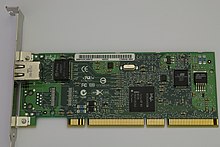PCI-X
| PCI Local Bus | |

A PCI-X Gigabit Ethernet expansion card.
|
|
| Year created | 1998 |
|---|---|
| Created by | IBM, HP, and Compaq |
| Superseded by | PCI Express (2004) |
| Width in bits | 64 |
| Speed | 1064 MB/s |
| Style | Parallel |
| Hotplugging interface | yes |
PCI-X, short for Peripheral Component Interconnect eXtended, is a computer bus and expansion card standard that enhances the 32-bit PCI local bus for higher bandwidth demanded mostly by servers and workstations. It is a double-wide version of PCI, running at up to four times the clock speed, but is otherwise similar in electrical implementation and uses the same protocol.
It has been replaced in modern designs by the similar-sounding PCI Express (officially abbreviated as PCIe), with a completely different connector and a very different logical design, being a single narrow but fast serial connection instead of a number of slower connections in parallel.
In PCI, a transaction that cannot be completed immediately is postponed by either the target or the initiator issuing retry-cycles, during which no other agents can use the PCI bus. Since PCI lacks a split-response mechanism to permit the target to return data at a later time, the bus remains occupied by the target issuing retry-cycles until the read data is ready. In PCI-X, after the master issues the request, it disconnects from the PCI bus, allowing other agents to use the bus. The split-response containing the requested data is generated only when the target is ready to return all of the requested data. Split-responses increase bus efficiency by eliminating retry-cycles, during which no data can be transferred across the bus.
PCI also suffered from the relative scarcity of unique interrupt lines. With only 4 interrupt lines (INTA/B/C/D), systems with many PCI devices require multiple functions to share an interrupt line, complicating host-side interrupt-handling. PCI-X added Message Signaled Interrupts, an interrupt system using writes to host-memory. In MSI-mode, the function's interrupt is not signaled by asserting an INTx line. Instead, the function performs a memory-write to a system-configured region in host-memory. Since the content and address are configured on a per-function basis, MSI-mode interrupts are dedicated instead of shared. A PCI-X system allows both MSI-mode interrupts and legacy INTx interrupts to be used simultaneously (though not by the same function.)
The lack of registered I/Os limited PCI to a maximum frequency of 66 MHz. PCI-X I/Os are registered to the PCI clock, usually through means of a PLL to actively control I/O delay the bus pins. The improvement in setup time allows an increase in frequency to 133 MHz.
...
Wikipedia
